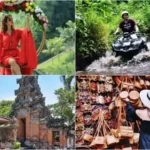Ubud Monkey Forest is just in the Ubud Center’s southern part. Padangtegal Ubud’s Sacred Monkey Forest monkeys are commonly referred to as long-tailed macaques. Macaca fascicuiaris is their scientific name. Macaques are found throughout Southeast Asia, and many species of macaques are successfully living in areas heavily used by humans.
In Bali, Balinese long-tailed macaque (populations) live in zones where they have little or no contact with human beings and regular contacts with human beings. Nevertheless, despite the fact that many species of macaques flourish in areas which are widely used by humans the viability of Balinese long-tailed macaques can be dependent on the preservation of the forested areas of Bali.
In long tailed macaque societies, female are generally born into a single troop and remain for life. On the other hand, adult and sub-adult males may migrate among troops (typically young adult males leave their birth troops between the ages of 4 to 8).
In order to be accepted into a new troop by a migrating adult or sub-adult male, migrating males must align with the females of a troop and be accepted by those females. Long-tailed macaque societies or troops are therefore composed of’ matrilines'(‘ matri’ is a root word meaning’ mother’).
There are currently about 605 Balinese long-tailed macaques in the Sacred Monkey Forest of Padangtegal (39 adult males, 38 male sub adults, 194 adult females, 243 juveniles and 91 infants). These long-tailed macaques, however, are not part of the same troop. In fact, there are 4 distinct troops in the Sacred Monkey Forest.
Tourists tend to have a hard time identifying the long-tailed macaque troops of the Sacred Monkey Forest. One reason for this is that the area(s) that each of the troops occupies mainly change over time within the boundaries of the Sacred Monkey Forest.
Changes in the range of each troop are partly dependent on variations in the number of individuals within each troop and changes in the composition of each troop (age and sex of individuals within a troop).
Finally, tourists have a hard time identifying each of the long-tailed macaque troops of the Sacred Monkey Forest because the ranges of all the troops of the Sacred Monkey Forest can overlap extensively. Occasionally this overlap in ranges causes inter-troop conflicts to break out (conflicts break out between 2 or all 3 macaque troops of the Sacred Monkey Forest).
As a result of these conflicts, engaging in violent physical clashes is not uncommon for troops. While it is rare for individual macaques to sustain life-threatening wounds as a result of participating in an inter-troop clash, macaques are not uncommon to sustain wounds that leave permanent scars.
It has also happened, however, that the whole group can use the forest and they will fight each other when two groups exist at the same place and time. These monkeys are believed to exist in the middle of the forest as the Gods Guard of Dalem Agung Temple, the Hindu Temple.
In this monkey forest there are three Holy Temples, and those surround the forest, and it is estimated to be built in the middle of the 14th century, in the early Gelgel dynasty governance. Located northwest of the forest, Dalem Agung Temple represents the existence of the most important temples.
Next to two others, the Permandian Temple (Holly Spring Temple), located on the west side of this forest and the Prajapati Temple, located on the south-east side where Dewa Siwa (Siwa God), one of the Khayangan Temple in Padang Tegal Village, is located.





